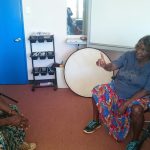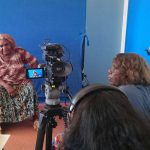The Ti Tree Iltyem-iltyem team have been working together this week (4-7 May 2015). Clarrie Kemarr Long, Eileen Pwerrerl Campbell, Sonya Drover, Jenny Green and Margaret Carew held recording sessions based at the Ti Tree School, working mostly on birds and mammals. Eileen and Clarrie checked their signs against Adam Kendon’s lists and also recorded information in sign and speech for each one. We were investigating the way that signs for birds and mammals are based on characteristics of the animal – such as its appearance or colour, the way the animal moves, where it lives or how it is hunted.
When discussing the signs for particular animals, Clarrie and Eileen held detailed sign conversations, describing the characteristics of the animal. For some animals, Eileen and Clarrie said there was no sign, although they said that old people may have known the sign once. Their sign conversations are interesting because they are rich in sign and they are excellent examples of the way that sign, gesture and speech work together.
We also recorded signs for everyday things, such as tea, cake, biscuit, jam and camp oven. These are all items that became part of Aboriginal life in relatively recent times. New signs came about as these things were encountered, and people taught these signs to others. These now seem to be well-established conventional signs, not just gestural descriptions. Knowing what is a ‘sign’ and what is a general description is not straightforward. This makes us think about how new signs are formed, what they are based on and how they become conventionalised in a community of signers.
This film – called Mwekel mern cake arlkwem ‘Mum eats cake’ – shows Eileen Pwerrerl Campbell demonstrating the signs for CAKE and BISCUIT, along with MWEK / MOTHER, MERN / FOOD and ARLKWEM / EAT. CAKE has a similar handshape to MWEK / MOTHER, but Eileen shows how these two signs are different.

